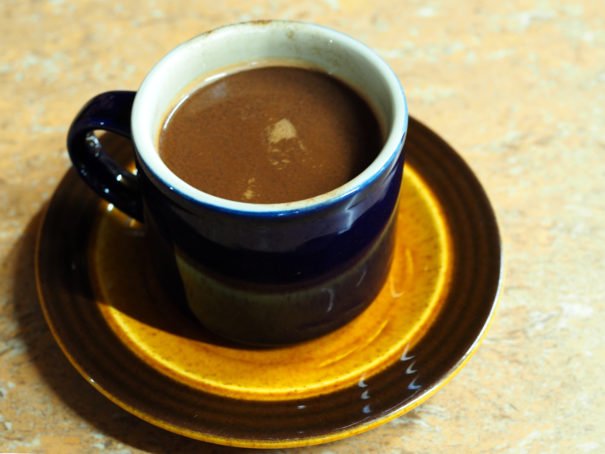
A Steaming Cup of Grainy, Bitter, Oily Chocolate

A Steaming Cup of Grainy, Bitter, Oily Chocolate
Tsokolate in Mindanao
We drink it black, sipping slowly. It’s not coffee, but the steaming liquid is thick, grainy, and bitter. I’m starting to feel pleasantly, mildly buzzed.
I ask for another cup. On the other side of the counter, an old woman in a hairnet and apron drops a round coin of pure cocoa, called tablea, into a cast-iron pitcher. She flicks on the single burner, glowing blue in the dim cave-like light of the market building, and while the water warms slides a plate of puto maya on heavy white and blue china to me. Although the cold, gummy rice is sweet and salty, the perfect complement to the hot, oily drink, I’m not hungry. I have appetite only for chocolate.
I’m visiting Mindanao, the second-largest island in the Philippines, which grows 75 percent of Philippine cocoa. The statistic that gets more attention is the island’s demographic—20 percent of the population is Muslim in a nation overwhelmingly Roman Catholic.
When the Spanish conquistadors arrived here in the 16th century, after a hundred years battling the Moors, they were dismayed to find a powerful Islamic Sultanate. Spaniards called them Moros, and set about spreading Catholicism and, inadvertently, the drinking chocolate called sikwate in the local dialect, but known nationally as tsokolate.
According to Historia de Filipinas by Gaspar de San Augustin, the introduction of cocoa to the Philippines can be credited to Father Bartolome Brabo, a Jesuit missionary who received a shipment of beans from a Mexican convent in 1670. Chocolate was so associated with Spanish priests that a Philippine parable, made famous in the 1886 novel Noli Me Tangere, involves the dangers of accepting different kinds of drinking chocolate from a priest.
Monasteries became centers of cocoa production, processing the beans into tablea and oil for lighting homes and city streets. When I glance up from slurping the gritty grounds at the bottom of my mug, the gleam from a lacquer Jesus-on-the-cross catches my eye.
Philippines has long exported the raw cocoa beans, but recently the national government endorsed assistance programs to encourage making gourmet-grade tsokolate for the world market, and not just these comfy little breakfast counters.
The woman uses a wooden mallet called a batirol to whip the steaming liquid into foam and refills my mug. I add a teaspoon of dark brown sugar from the little bowl on the counter, cutting the bitterness.